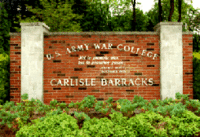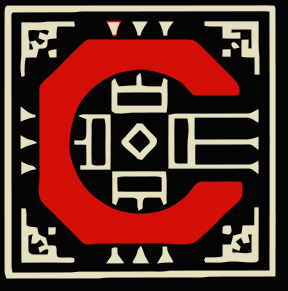Carlisle Barracks facts for kids
Quick facts for kids Carlisle Barracks |
|
|---|---|
| Carlisle, Pennsylvania | |

US Army War College
|
|
| Type | School post |
| Site information | |
| Controlled by | Headquarters, Department of the Army |
| Site history | |
| Built | May 1757 |
| In use | Currently |
|
Pennsylvania Historical Marker
|
|
| Designated: | N/A |
Carlisle Barracks is a United States Army base located in Carlisle, Pennsylvania. It's home to the U.S. Army War College and is the second-oldest active military base in the United States. The first buildings were put up in 1757 during the French and Indian War, which was a big fight between Great Britain and France in the American colonies.
From 1879 to 1918, the land was used by the Department of Interior to run the Carlisle Indian Industrial School. This was the first school of its kind, built away from Native American reservations. Its goal was to teach Native American children English, trades, and new ways of life, hoping they would fit into European-American culture. After the United States joined World War I, the school closed, and the land went back to the Army.
Contents
Early Days: 1756 to 1860
Carlisle town grew where old Native American trails met near Letort Creek. In the 1700s, it became a starting point for traders and settlers heading west over the Allegheny Mountains. A temporary camp was set up in Carlisle in 1756, and then a more permanent base started in May 1757. This was during the French and Indian War, a conflict between the British and French colonies in North America. Colonel John Stanwix led British soldiers and local troops here. After the American Revolutionary War (from 1783 to 1837), Carlisle was an important "gateway" as many people moved west to find land.
During the Revolutionary War, many strong brick buildings were built at Carlisle Barracks. These were used to store military supplies and house workers for the Army's managing group, the Board of War and Ordnance. One important building, the Hessian Powder Magazine, now called the Hessian Guardhouse Museum, was built in 1777.
In 1794, Carlisle Barracks became very busy when the Whiskey Rebellion broke out in western Pennsylvania. Farmers there refused to pay a tax on the whiskey they made from their corn. Whiskey was easier to transport and sell than corn itself. President George Washington even came to the barracks to see the troops, perhaps as many as 10,000 men, who were gathered to deal with the rebellion.
President Washington thought the barracks would be a good spot for a national military academy. However, West Point in New York was chosen instead. In 1801, the government officially bought the 27 acres (about 110,000 square meters) of land for $664.20, which they had been renting from William Penn's family.
In 1838, the US School of Cavalry Practice started at Carlisle Barracks. This was for the Army's small but skilled mounted soldiers, called U.S. Dragoons. It was a very early version of what is now the Armor School. Captain E. V. Sumner found many of the buildings needed repairs, and there weren't enough horses. He even had his recruits run fast on foot to pretend they were riding horses! Another group, the horse-drawn light artillery, also set up its school here. In 1839, Captain Samuel Ringgold arrived to train recruits for the "flying artillery," which was a fast-moving type of cannon.
Carlisle Barracks During the Civil War
In the early days of the American Civil War, people in south-central Pennsylvania often heard rumors that Confederate soldiers were coming up the Shenandoah Valley and Cumberland Valley from Virginia. Even though it was far from the main fighting, Carlisle Barracks became a key place to store weapons, horses, and other supplies. New soldiers, who were once going to fight Native Americans in the west, were now trained to replace those lost in the Civil War. Whole army units came to the barracks to get new supplies before heading out to battle.
In June 1863, the cry "the Rebels are coming!" became real. Despite a small local defense force, Confederate cavalry led by Brigadier General Albert G. Jenkins entered Carlisle on June 27. Jenkins's soldiers camped nearby and took food from the town for his 1,500 men and their horses. Three North Carolina groups of soldiers stayed at Carlisle Barracks, camping on the parade grounds.
Major General J.E.B. Stuart's cavalry arrived from the east on July 1. His troops were tired from a long march around the Union Army and hoped to find supplies. Stuart didn't know that other Confederate units had already taken most of the supplies from Carlisle. Stuart demanded that the Federal forces, led by Brigadier General William Farrar Smith, surrender. When they refused, Stuart started a short attack with cannons. After a second refusal, Stuart ordered his troops to fire on the town and later set fire to the barracks. This event is known as the Battle of Carlisle.
After the Civil War ended, the barracks went back to its old job of training cavalry soldiers for battles on the western frontier. But as army operations moved further west, the War Department moved this training to the St. Louis Arsenal in Missouri. This location had better access to transportation on the Mississippi and Missouri rivers. So, on April 20, 1871, Carlisle Barracks was officially closed as a training center for mounted soldiers. The base was then ready for new uses.
Carlisle Indian Industrial School
In 1879, the Army gave control of the base to the Department of the Interior. The US Congress had approved the Bureau of Indian Affairs (BIA) to open the first school for Native American children that was not on a reservation. During and after the Indian Wars, the US government wanted to find a way to help Native American children learn English, trades, and Christian beliefs, hoping they would join European-American culture.
The Carlisle Indian Industrial School officially opened on November 1, 1879, and ran until 1918. Some of the first students were children from Sioux (Lakota) groups who had fought against the US. The Indian Bureau sent these children to the school as part of a government effort to encourage Native American tribes to cooperate and adopt new ways of life.
General William T. Sherman agreed to Richard Henry Pratt's idea to use the barracks for this special school. Pratt wanted children to learn English and European-American customs, get an education away from their reservations, and live among European-American people. He believed this education would help Native Americans protect their lands and cultures. Pratt became the school's founder and first leader. His ideas for the school came from his experience since 1875, teaching Native American prisoners of war at Fort Marion in St. Augustine, Florida. Some young Native American men even went on to study at Hampton Institute, a historically black college, and other private schools in New York.
Carlisle Barracks: 1918 to 1950
On September 1, 1918, during World War I, the U.S. Army took back Carlisle Barracks from the Department of Interior. The Army used the base to meet its changing needs. After World War I ended, the U.S. Army set up General Hospital No. 31 there. This was a new kind of center for helping soldiers recover. For two years, the hospital gave medical care, mental support, and job training to over 4,000 soldiers who had returned from fighting in France. The equipment lab at Carlisle Barracks also designed and tested new things, like better lights for field hospitals, a portable dental office, first aid kits for arctic rescues, and the "First-aid Packet, U.S. Government Carlisle Model" bandage.
In the fall of 1920, the Medical Field Service School was started under Colonel Percy M. Ashburn. Learning from World War I, the school created medical equipment and ways of doing things that were useful on the battlefield. More than 30,000 officers and NCOs (non-commissioned officers) trained at this school during its 26 years at Carlisle Barracks. They learned in classrooms and practiced in the field how to care for injured soldiers and prevent diseases, which used to be a huge problem for the military before better sanitation and medicines like antibiotics.
When the Medical Field Service School moved to Fort Sam Houston in San Antonio, Texas, after World War II in 1946, new types of education continued at Carlisle. From 1946 to 1951, six different U.S. Army schools were located at Carlisle Barracks. First was the Army Information School, then the School for Government of Occupied Areas, and the Adjutant General's School for army personnel managers. The next year, the Chaplain School and the Military Police School arrived. Finally, the Army Security Agency School began secret operations in 1949 and stayed for two years before moving.
United States Army War College
In the spring of 1951, the United States Army War College moved to Carlisle Barracks in central Pennsylvania. This college is the top educational institution for the U.S. Army. It was first started in 1903 in Washington, D.C., and its main job was to prepare selected officers for high command roles. Famous graduates from that time include John J. Pershing (Class of 1905), Dwight D. Eisenhower (1927), and Omar N. Bradley (1934).
Classes were stopped in 1940 as the country prepared for World War II. They didn't start again until ten years later at Fort Leavenworth, Kansas, for the 1950–51 school year. The new leader, Lieutenant General Joseph M. Swing, moved with the college to Pennsylvania in July 1951. He then handed over command to Lieutenant General Edward M. Almond just in time for the first class at Carlisle.
At Carlisle, the Army War College grew steadily, adding new programs and special studies. The college outgrew its main academic building (which is now Upton Hall). In 1967, it moved to Root Hall, a new building made to fit its needs. Two special groups became important parts of the Army War College: the Strategic Studies Institute, started in 1954, and the Military History Institute, created in 1967. The Center for Strategic Leadership, a very modern war gaming complex, opened in 1994, using more and more advanced technology.
In 2005, Carlisle Barracks was considered for closure as part of a military base review, but it was later removed from the list. In 2006, work began on a big project across the road from Carlisle Barracks: building new military homes. This work had been put off until the review was done. It was part of a program to build housing with both public and private money. In Carlisle, this project included fixing up some old historic homes and building almost 200 new homes, each with 3-4 bedrooms and over 2000-2500 square feet of space.
Images for kids




